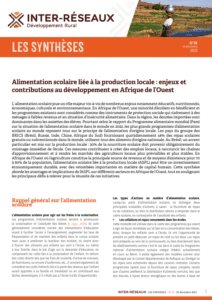Urbanization is one of the key drivers of change in the world today. The world‟s urban population currently stands at around 3.5 billion. It will almost double to more than 6 billion by 2050. This is a challenge not only for urban areas but also for rural areas, because many people, especially the young, will migrate from rural areas to urban areas over this period. When addressing urbanization challenges, we are also addressing, directly or indirectly, rural and territorial development. What do we have to do to ensure people‟s access to good nutrition in cities? What do we have to do to produce enough food for urban dwellers? What infrastructures are needed and what kind of food production is possible in cities? How can cities preserve the services of the surrounding ecosystems? A very wide range of important issues links urbanization and food security.
The “Food for the Cities” multidisciplinary initiative started in FAO in the year 2000. It has covered a great variety of areas such as food supply, nutrition education, school gardens, urban and peri-urban agriculture and forestry; how to support small producers in urban and peri-urban areas, waste management and re-use of wastewater. The experience shows conclusively that we all need to work in partnership when addressing issues of urbanization and food security, from the public sector, the private sector and civil society.
Local authorities are key players in this context, however, urban actors have often not considered the food system an important issue when designing, planning and managing cities. The perception has been because food is there and one can easily buy it in the supermarkets or along the streets, that food will always be there. This perception was altered for many in 2008, when the food prices peaked. More than 20 countries around the world experienced food riots in urban areas. Hunger, now in both rural and urban areas, has now become vocal, and this is changing the political scene. All stakeholders need to work together at global and local levels, for advocacy, for project implementation, but also for raising awareness on urbanization and food security as one of the key issues of our times.
This position paper addresses a wide audience, from field workers to decision makers, to help understand the challenges that continuing urbanization brings to food, agriculture, and the management of natural resources. The approach proposed here is based on four dimensions that characterize, design and implement food systems for cities. The paper has been prepared as a support for all actors to help advocate for political support and to assist in developing operational strategies adapted to local realities.
Food and nutrition security in cities can not be taken for granted. It is part of a complex system. Supporting the most vulnerable groups in an urbanizing world demands discussions on food, agriculture and cities in the context of rural-urban linkages.
To read the document (48 p.) : http://www.fao.org/fileadmin/templates/FCIT/PDF/FoodAgriCities_Oct2011.pdf







